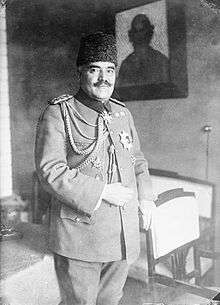Zeki Pasha
| Zeki Pasha 1299 (1883) Sv.[1] | |
|---|---|
 Zeki Pasha, in January 1918. | |
| Nickname(s) | Halepli Zeki |
| Born |
1862 Aleppo, Ottoman Empire |
| Died |
1943 (aged 80–81) Istanbul, Turkey |
| Allegiance |
|
| Service/branch |
|
| Years of service | 1883–1923 |
| Rank | Müşir (Field Marshal) |
| Commands held | Vardar Army, 2nd Army, 4th Army |
| Battles/wars |
Greco-Turkish War Italo-Turkish War Balkan Wars World War I |
| Other work | Private representative of Sultan Mehmed V at Berlin |
Zeki Pasha or Zekki Pasha or Zeki Kolaç[2] or Mehmet Zeki Baraz[1] (Turkish: Halepli Zeki Paşa; 1862–1943),[3][2] known as Zeki Baraz Kolaç Kılıçoğlu after the 1934 Surname Law,[3] was a Balkan Wars and World War I Müşir (Field Marshal) of the Ottoman forces in the Balkans.
He graduated from the Ottoman Military Academy in 1883 and the Staff College in 1887.[3] In 1894, as Commandant of the IV Corps, he was decorated for his participation during the Sassoun massacre.[4][5][6] During the massacres, he reportedly stated, "not finding any rebellion we cleared the country so none should occur in the future."[7]
In 1912–1913, he was commander of the Vardar Army during the First Balkan War. Following the orders of Nazim Pasha, Chief of Staff of the Ottoman Army, Zeki Pasha initiated the Battle of Kumanovo.[8]
His failure to emplace key artillery hindered the forces under his command and led to their defeat at Kumanovo.[9] During the frantic Ottoman retreat from Kumanovo, a disgruntled Ottoman soldier attempted to assassinate him, contributing to the panic.[10] The Vardar Army; consisting of the VII Corps commanded by Fethi Pasha, the VI Corps commanded by Djavid Pasha and the V Corps commanded by Kara Said Pasha, all under Zeki Pasha's command, retreated to Monastir (present day: Bitola) after the defeat at Kumanovo.[11]
Zeki Pasha established a strong defensive position on the Oblakovo heights northwest of Monastir prior to the battle. However, during the Battle of Monastir, Serbian artillery and infantry managed to defeat the Ottomans. Fethi Pasha was among the casualties.[12]
On 21 November 1914, he was assigned the Ottoman liaison officer to Kaiser Wilhelm II and was sent to German Empire. After armistice, he returned to Constantinople and served as the Ottoman Chief of General Staff between 23 October 1920 and 1 November 1922. He retired from the army in 1923.
References
- 1 2 Harp Akademileri Komutanlığı, Harp Akademilerinin 120 Yılı, İstanbul, 1968, p. 45. (Turkish)
- 1 2 İzzettin Çalışlar, On yıllık savaşın günlüğü: Balkan, Birinci Dünya ve İstiklal Savaşları, Yapı Kredi Yayınları, 1997,
- 1 2 3 Ekmeleddin İhsanoğlu name, Osmanlı Askerlik Literatürü Tarihi: History of Military Art and Science Literature during the Ottoman Period, İslâm Tarih, Sanat ve Kültür Araştırma Merkezi (IRCICA), 2004,
- ↑ Robert Melson, "Revolution and Genocide" (1992), p.60
- ↑ W. Blackwood, "Blackwood's Edinburgh Magazine" (1897),p.21
- ↑ George Shaw/Lefevre Eversley, "The Turkish Empire from 1288 to 1914" (1914), p. 341
- ↑ Arman Dzhonovich, "The Armenian Massacres, 1894–1896" (2004), pp. 63–64
- ↑ Richard C. Hall, "The Balkan Wars, 1912–1913: Prelude to the First World War" (2000), p. 47
- ↑ Hall,p. 48
- ↑ Hall, p. 49
- ↑ Hall, p. 51
- ↑ Hall, p. 52